Wednesday, November 7, 2012
A Day with Capt. Dan Blanton
Almost two years ago I had won a guided trip on the CA Delta with Capt. Dan Blanton. For various reasons; whether it be weather or his busy guiding schedule, the trip hadn't happened until last month. This season, he decided to quit guiding and just enjoy the fishing. For some reason decided he still had an obligation to a few people to take em out and I was one of the lucky ones. For those of you that dont know who Dan Blanton is, just Google it. The man is like the godfather of striper fishing out here on the CA Delta. He runs a very popular forum here, and hosts/organizes StriperFest each year to raise thousands of $$ to protect the CA Delta striped bass.
For those of you that haven't been out on the CA Delta, or even those who have, it can be very overwhelming. I mean the place can get you lost, spun around, bass-ackwards, and not to mention get you run over by a Japanese barge rolling in to port at any time. Its crazy and definitely nice to learn a bit about the place from someone who has fished there for 40+ years.
To the day. I met Blanton at his skiff at the Sugar Barge around 7, and he was there already getting things ready. We headed out to the main channel of the San Joaquin and at his first spot we were going to hit up was already taken. Go figure as we roll up the guy is throwing top water spooks and bam catches a 17 lber! I was like this is going to be a good day. We move on to the next spot and the fog is really moving in. First few casts and pow a nice 4 lber. from there we landed a few more and the by that time the tide was slackining and fishing got tough. We headed from spot to spot til about 5, each landing around a half dozen keeper stripers and about the same LMB. Cant say the fishing was great but the time learning about the amazing fishery and techniques are invaluable things that will lead to great days in the future I'm sure. Thanks Dan and can't wait to get back out there. I've been hearing the bigger fish are moving in. Here are a few pics from the day..Stay Fly! D
Wednesday, October 31, 2012
End of the Season
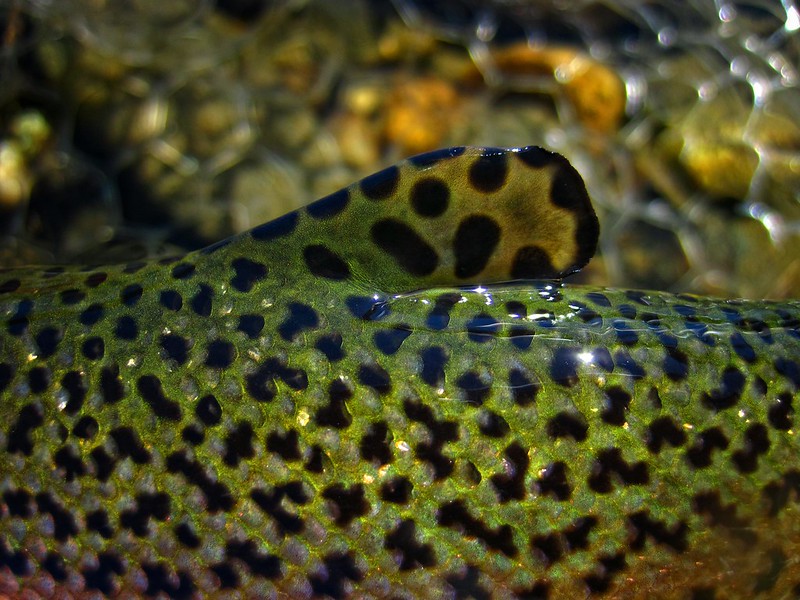
As I'm sitting here writing this, the date is October 31st, 2012. The Giants just won the World Series and I'm waiting to hand out candy to trick or treeters. Although this day is just Halloween for most, those that fly fish in the Central Valley of California know this day also as the last day of the season. The decimated population of local salmon that call these rivers home is the reason for this. In the fall these fish are called back to the river in which they were born to spawn and then die. This is a good closure and allows these salmon to not be disturbed, albeit tough for those who fish these rivers frequently. This two month break allows us to spend some time at the vise, restock the fly boxes, and check out other fishing opportunities. It is also a time to reflect and look back on the year. I, along with those I fished with, had a remarkable season on the Stanislaus, Tuolumne, and Merced rivers. The trout fishing was excellent and we were even met with a few river stripers. It was also a definite big fish year with many fish at or above the proverbial 20" mark. Still looking for Hog Johnson though! I know I'll find him one of these days on one of these rivers. Anyway, I'll let the photos tell the rest of the story from this year! Hopefully next year can match the one we had this year!
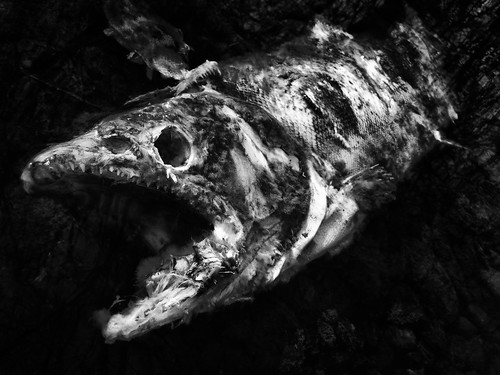


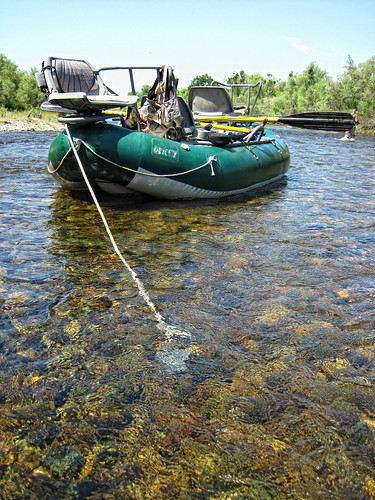

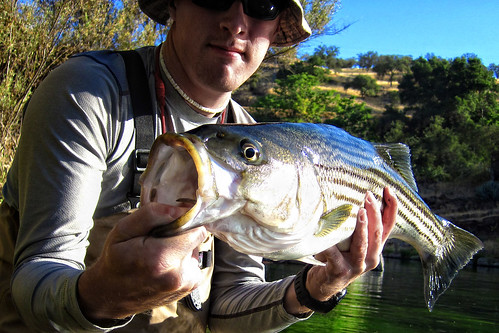
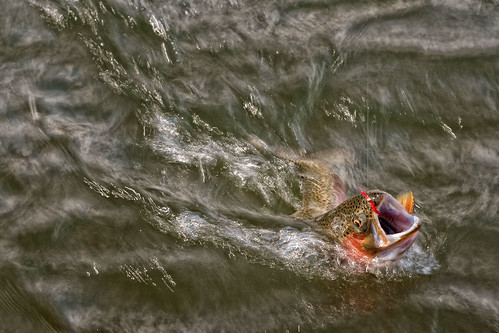

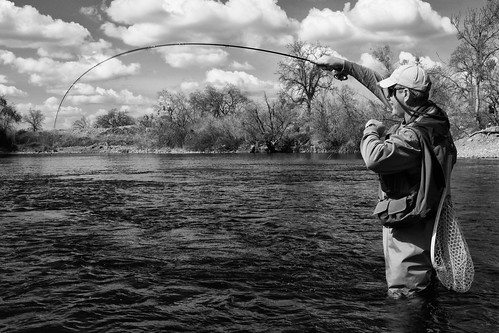
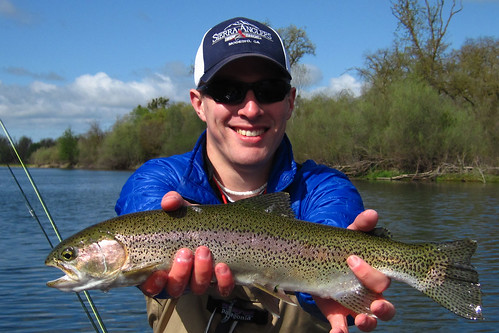
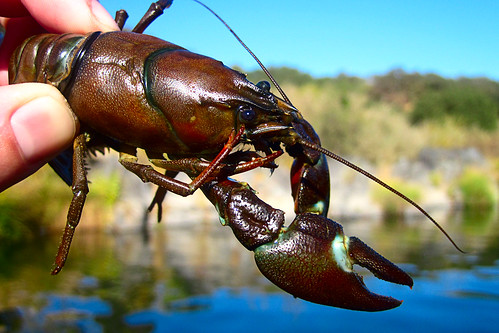
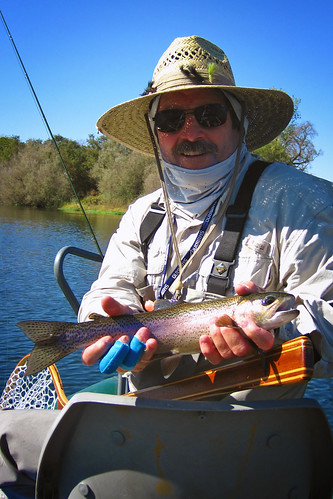
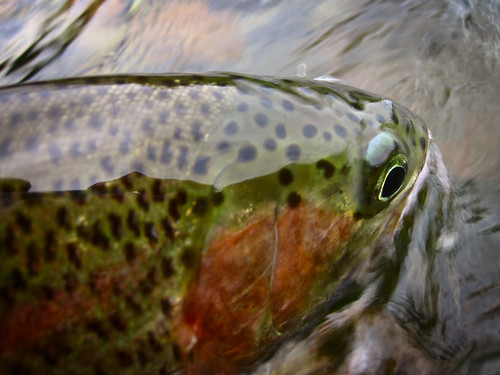
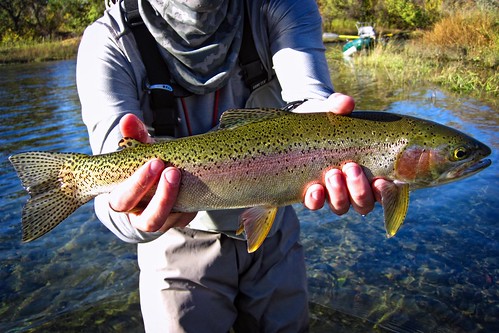
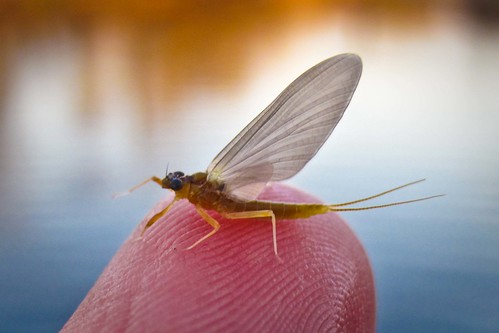
Monday, October 1, 2012
The GSF Fly Tying Series Vol. 2 - The Tickler
This one goes out to all the swingers! Well.....those that swing the FLY to be specific. With this edition of our Fly Tying Series we decided to go with a pattern for anadromous oncorhynchus mykiss. Yes, that means steelhead! I've become hooked on swinging for steelhead (and trout for that matter) this past year and wanted to highlight a pattern for the swing. After coming across Rich Zellman's Tickler, I knew I had found a pattern I wanted to do for this series. The Tickler is an intruder-style fly, but utilizes some different materials and techniques that I had never seen used in this capacity. It's a fun fly to tie, albeit complex, but definitely worth it! This fly has met many winter steelhead face-to-face and elicited a grab. The color scheme in the original pattern is a black/blue/pink combo, but can easily be changed to suit any tyer's desire. I tied a black/chartreuse combo that I think looks absolutely killer too. Anyway, hope everyone enjoys this video! Thanks for watching! Tie up a few ticklers and swing them this winter! I know I will.
Stay Fly,
T
Materials
Shank: Waddington Shank, size 35mm or Salmon/Steelhead hook (like Tiemco 7999 or Alec Jackson), size 2/0 cut and straightened
Hook: Owner SSW, size 2
Connection: Econoflex Craft & Beading Wire, 20lb, midnight black
Thread: Black
Butt: Ice Dub UV fluorescent hot pink dubbing ball
Rear collar: Black turkey flat
Tail: Black ostrich herl
Body: Fluorescent cerise Krystal Flash for the rear 3/4 and STS Trilobal Kingfisher blue dubbing ball for the front 1/4
Hackle: Black pheasant tail, stripped off of the stem and palmered
Shoulder: Fluorescent blue ostrich herl over fluorescent blue turkey flat
Collar: Fluorescent blue guinea
Wing: Pair of fluorescent blue grizzly saddle tips
Topping flash: Light blue Flashabou #6915
Eyes: Large lead eye dumbbells
Head Cement: Clear Cure Goo Thin
Stay Fly,
T
Materials
Shank: Waddington Shank, size 35mm or Salmon/Steelhead hook (like Tiemco 7999 or Alec Jackson), size 2/0 cut and straightened
Hook: Owner SSW, size 2
Connection: Econoflex Craft & Beading Wire, 20lb, midnight black
Thread: Black
Butt: Ice Dub UV fluorescent hot pink dubbing ball
Rear collar: Black turkey flat
Tail: Black ostrich herl
Body: Fluorescent cerise Krystal Flash for the rear 3/4 and STS Trilobal Kingfisher blue dubbing ball for the front 1/4
Hackle: Black pheasant tail, stripped off of the stem and palmered
Shoulder: Fluorescent blue ostrich herl over fluorescent blue turkey flat
Collar: Fluorescent blue guinea
Wing: Pair of fluorescent blue grizzly saddle tips
Topping flash: Light blue Flashabou #6915
Eyes: Large lead eye dumbbells
Head Cement: Clear Cure Goo Thin
Saturday, September 8, 2012
The GSF Fly Tying Series Vol. 1 - The Wedding Veil
Recently, Daniel and I decided to embark on a new project involving filming new and proven patterns in an entertaining way. Most fly tying videos can be somewhat boring and strictly informative. We decided to try and break this mold by producing videos that stay informative but also are entertaining to watch. The fly we chose to kick off this series is the Wedding Veil, created by Thomas Harvey. This pattern is deadly in the water and is sure to bring in some nice bass. This fly also highlights some newer products, such as the Clear Cure Eyes. These eyes are weightless and constructed like traditional dumbbell lead eyes, but obviously without the weight of lead. Because of this design they are also far superior to regular stick on eyes due to the fact they won't fall off. One of the other key points to make about this fly is its customizability. The original pattern calls for a zonker strip for a tail but many different materials can be substituted for this. For example, in the video Daniel uses hackle feathers. Anyway, check it out!
Stay fly,
T
Intro Video
The Wedding Veil
Stay fly,
T
Intro Video
The Wedding Veil
Monday, August 27, 2012
The Dead Drift Crayfish

(Truckee River crayfish)
A few years back during a random time-wasting YouTube session, I stumbled on Andy Burk's page. After checking out a few tying videos I came across one about a dead drift crayfish pattern tied by Tim Haddon. At the time, I had never tried fishing a crayfish pattern dead drifted so I thought I'd give it a whirl and tied up a few. Last September on the Truckee this pattern proved itself to be a good one for me. After using it on other rivers, such as the East Walker, it has found a home in my box. I typically fish this pattern as the top fly on an indicator set up with a smaller bug such as a baetis trailing. It serves as a great attractor and even if the fish aren't enticed to take the cray it'll get their attention. Anyway, I'm headed back to the Truckee next week and tied up a small arsenal of these and thought I'd do a tying segment on it. Here it goes!
(A barely hooked EW brown that fell for a dead drifted crayfish)
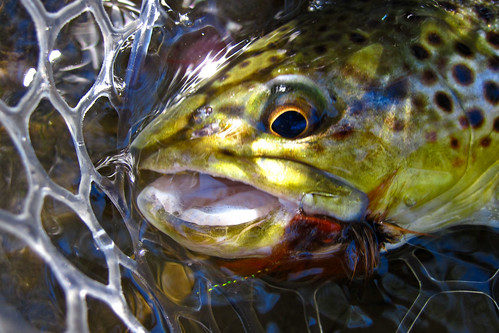
Materials
Hook: Tiemco 5263 #8
Thread: Danville black 6/0
Eyes: Small bead-chain
Weight: Lead wire .025
Antennae: Crawfish orange rabbit fur and turkey tail
Flash: Root beer krystal flash
Claws: Black-barred crawfish orange rabbit strips
Shell-back: Mottled thin skin
Rib: Black wire, size medium
Body: Blend of burnt orange and olive dubbing
Hackle: Saddle hackle, ginger color
1. Wrap the thread back to the point where the barb starts to flare up.
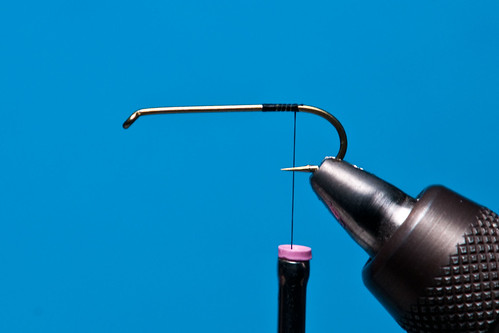
2. Tie in the bead chain eyes on the top of the hook by cross wrapping them. Make sure to lay down enough thread wraps to firms lock those eyes into place.

3. Wrap in about 20 or so turns of lead wire and push it back as close to the eyes as possible.

4. Coat the thread wraps with some glue (such as Fleximent or Loon Hard Head) and wrap thread over the lead to secure it in place.
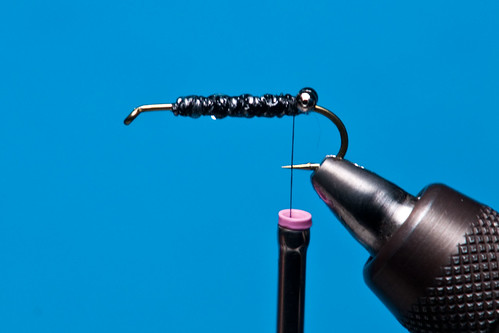
5. Tie in a clump of rabbit fur out the back of the hook.
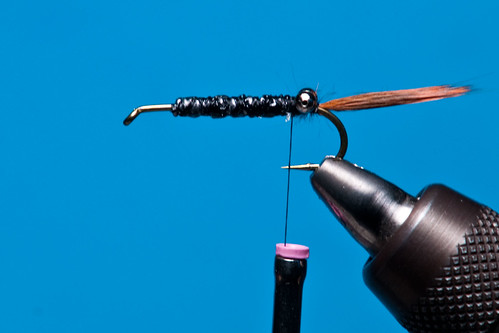
6. Next, cut 3 or 4 fibers from a turkey tail off and tie them on one side of the hook shank. Repeat this for the other side as well.
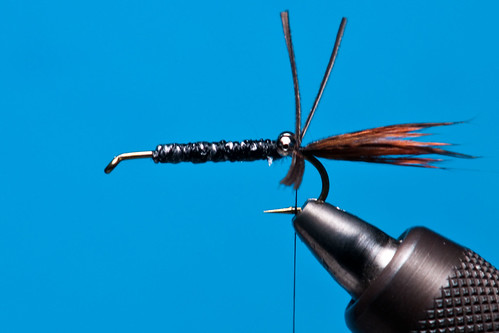
7. Then tie in 4 or 5 strands of krystal flash.
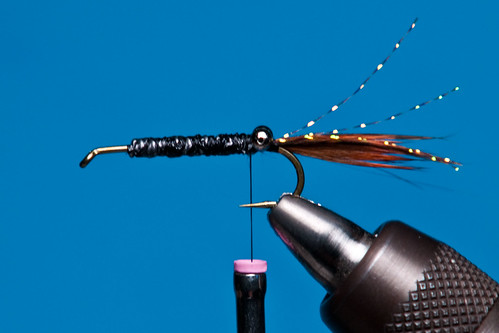
8. Cut out a piece of think skin that is just a little bit wider than the eyes and just a little bit longer than the hook shank. Taper this piece down and trim it so that it looks like the shape of a coffin.

9. Tie in the wider end of the piece of thin skin behind the eyes.

10. Hand blend up a bit of burnt orange and a bit of olive dubbing. This is a good color scheme for the Truckee River crayfish. (See the above picture)

11. Dub the head of the crayfish by cross wrapping it through the eyes.
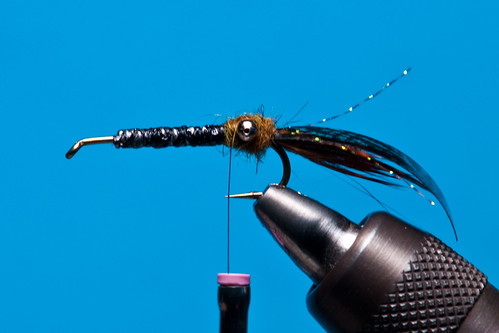
12. Cut 2 rabbit strips that are about an inch long. I like to cut points on the ends of the strips going out the back, but that is just purely aesthetic. Then tie in a strip on each side of the hook shank. Make sure to tie them as close to the eyes as possible. This helps flare the claws out as it drifts in the water.
(Top view)
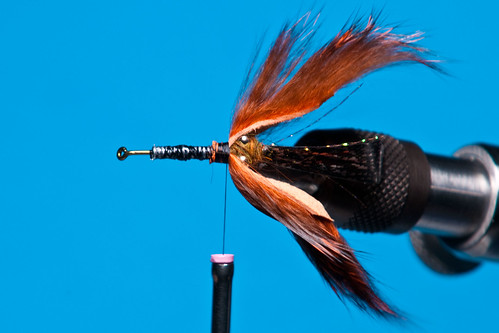
(Side view)

13. Wrap the thin skin over the head of the fly and secure it with a few turns of thread. Then pull it back out of the way.

14. Tie in about 4 inches of wire for the rib on the side of the hook shank.

15. Prepare a ginger hackle feather and tie it in at the base of the stem.
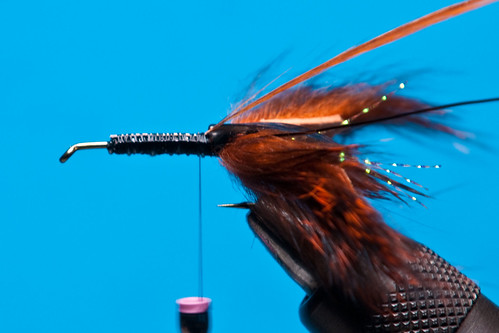
16. Dub a body of the same orange/olive blend. Gradually taper down the body as you move forward.
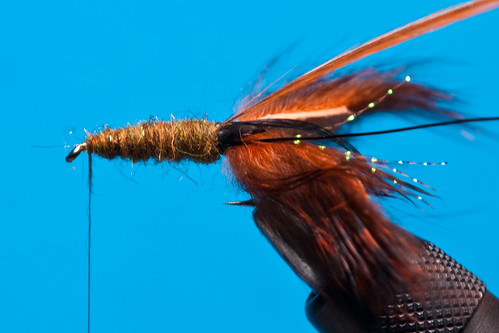
17. Palmer the hackle forward and tie off.

18. Cut the top fibers of the hackle off so the thin skin has a flat place to lay down.

19. Pull the thin skin over and tie off.

20. Counter wrap the wire to secure the thin skin and the hackle
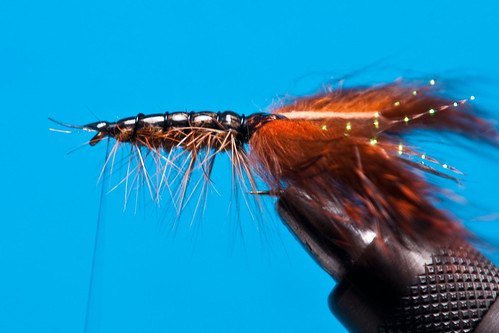
21. Whip finish and done!
(Top view)
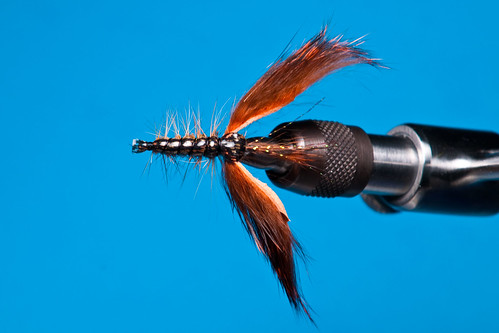
(Side view)
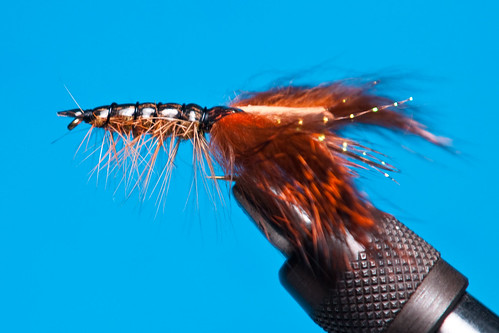
This fly isn't a 1-minute tie but if you tie it right, it is very durable and should last through many fish. Play with the color combos too. The original pattern uses more olive colors than the one I tie, but customization is one of the beauties of fly tying. Tie up a few and add them to your box!
Stay fly,
T
Friday, August 17, 2012
The Lost World of Soft Hackles

Let's face it.....most people fly fish with the bobber nowadays. It seems that when there's not a hatch, out comes the bobber (with a streamer thrown here and there). This method is undoubtedly effective and there's good reason why this method dominates. However, sometimes on certain types of water, this method doesn't seem as effective. I'm not going to lie, I was a slave to the bobber myself up until this past year, but given my newfound interest in swinging flies, soft hackles were one weapon I could fish with that method. These flies are profoundly simple and have been around probably just as long as fly fishing, but on today's pressured waters, confidence can be found swinging one. One of my local watersheds just isn't good nymphing water in my opinion. The structure of this river doesn't lend itself well to bobber fishing. Swinging is the way to go here and definitely my favorite style of fishing (maybe even more than the dry fly). Numbers of fish caught is something people throw around and on certain water types I feel the swung soft hackle will produce more fish. Oftentimes even in the middle of the day a soft hackle will grab a fish's attention. There's just something about it that elicits an aggressive reaction and a strong take. Anyway, here's an example of a simple soft hackle to get started with.
Materials
Hook: Tiemco 3769
Size: 14
Thread: Danville 6/0 Tan
Rib: Gold wire, Brassie size
Body: Tan UV Ice Dub
Collar: Hungarian Partridge
1. Wrap the thread on the hook shank
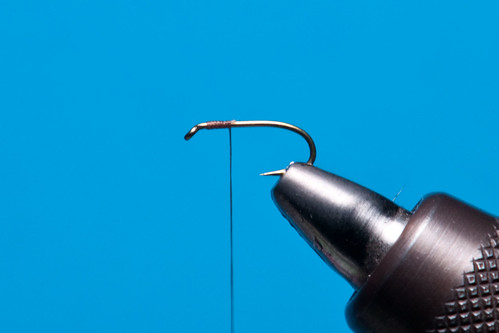
2. Tie in a piece of gold wire to about the bend of the hook.

3. Dub the body. Make sure to taper the body as you wrap forward.
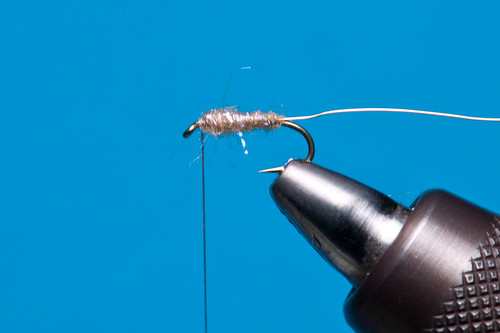
4. Rib the dubbing with the gold wire by counter wrapping it (wrap in the opposite direction of the dubbing) and tie off the wire about an eye length back.
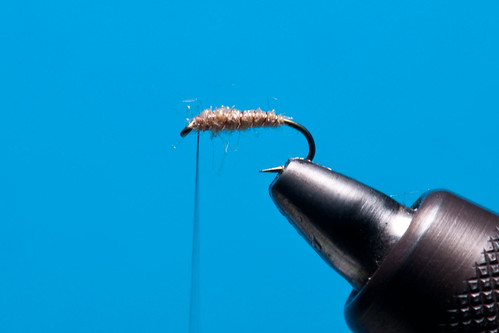
5. Prepare a hackle for the collar. To do this, pull off the fluff of the feather and stroke back the hackle fibers from the tip of the feather where you wish to tie it in at. The hackle fibers should extend farther than the hook bend.
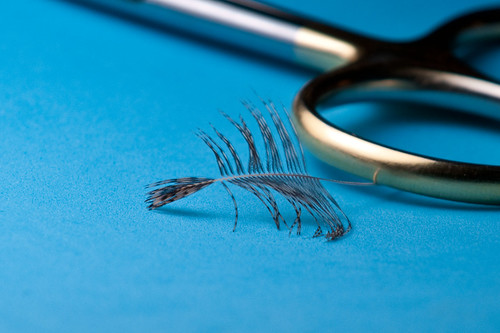
6. Tie in the hackle.
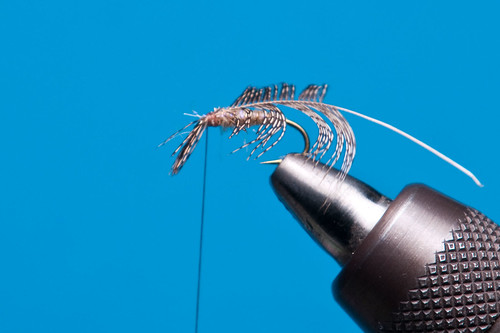
7. Wrap the hackle collar in and whip finish. When wrapping the fibers, make sure to stroke the feathers back as you wrap.
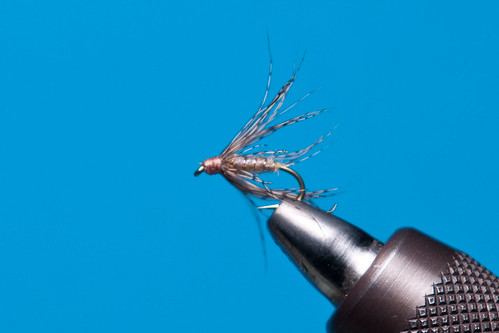
This is just a basic soft hackle. One can get as creative as they wish with these flies. Try different methods and materials. The fish most likely won't care much, but you'll develop confidence in certain patterns. The one in the tutorial is extremely simple but one of my favorites. Caddis colors often work well also. Creativity in these flies can make them fun to tie. Other good hooks to use are the Tiemco 3761 and the Tiemco 200R. The 200R resembles an Alec Jackson spey hook to me and has quite an awesome curve. I've tied some of my favorite steelhead patterns on these hooks for trout and they've worked quite well. Well, next time your out on the river and having trouble getting into fish, give a soft hackle a try. You might be surprised! Plus the bobber can use a break now and then!
(A few examples of traditional steelhead type wet flies tied on 200R's. These two patterns work great for trout.)

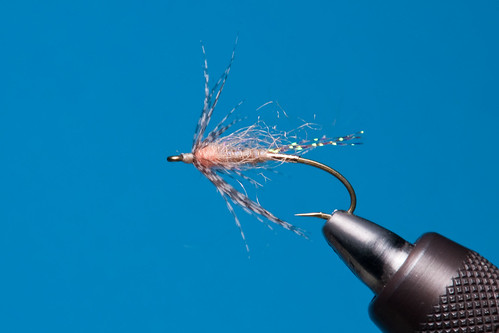
Stay fly,
T
Subscribe to:
Posts (Atom)






